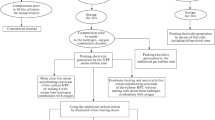Abstract
The operation of nuclear power plants routinely leads to the release of waste water flows contaminated with radioactive isotopes, tritium in particular. In order to prevent its entry into the environment, it is proposed to use a catalytic process of chemical isotope exchange in the water–hydrogen system. The novelty of the work lies in the combination of energy production facilities and commercial hydrogen into a single complex, which simultaneously allows the ecological problem of environmental protection to be solved. The proposal corresponds to the concept of atomic–hydrogen energy and is entirely based on the use of domestic developments.

Similar content being viewed by others
REFERENCES
Sources and Effects of Ionizing Radiation, Vol. 1: Sources, Report of United Nations Sci. Committee Effects of Atomic Radiation (United Nations, New York, 2010).
I. Fairlie, Tritium Hazard Report: Pollution and Radiation Risk from Canadian Nuclear Facilities (Greenpeace, London, 2007).
“Evaluation of facilities handling tritium,” Report of Canadian Nuclear Safety Commission (Minister of Public Works and Government Services, Ottava, 2010).
H. A. Boniface, N. V. Gnanapragasam, D. K. Ryland, et al., Fusion Sci. Technol. 67, 258 (2015).
Gh. Ionita, C. Bucur, I. Spiridon, et al., J. Radioanal. Nucl. Chem. 305, 117 (2015).
Yu. N. Zadonskii and N. V. Zadonskaya, in Proceedings of the Conference MNTK-2014, Moscow, p. 167.
http://www.rosenergoatom.ru.
Basic Sanitary Rules for Ensuring Radiation Safety (OSPORB - 99/2010): Resolution of the Chief State Sanitary Doctor of the Russian Federation, SP (Sanitary Rules and Regulations) No. 2.6.1.2612-10 (2010), No. 40.
Radiation safety standards (NRB - 99/2009): Resolution of the Chief State Sanitary Doctor of the Russian Federation, SP (Sanitary Rules and Regulations) SanPiN 2.6.1.2523–09 (2009).
“On the criteria for classifying solid, liquid and gaseous waste as radioactive waste, criteria for classifying radioactive waste as special radioactive waste and for removable radioactive waste, and criteria for the classification of removed radioactive waste,” Resolution No. 1069 of the Government of the Russian Federation of October 19, 2012.
M. B. Rozenkevich and E. P. Magomedbekov, Bezopasn. Okruzh. Sredy, No. 1, 90 (2009).
Assessment of the Environmental Impact of Placement, Construction and Operation. Kursk NPP-2, Vol. 1: Public Report of Atomenergoproekt (Moscow, 2015) [in Russian].
Yu. A. Egorov, Region. Ekol., Nos. 1–2, 13 (2002).
N. N. Del’vig, A. B. Ivanov, and V. A. Krylov, Ekol. Region. At. Stants. 5, 264 (1996).
B. M. Andreev, Ya. D. Zel’venskii, and S. G. Katal’nikov, Heavy Isotopes of Hydrogen in Nuclear Technology (IzdAT, Moscow, 2000) [in Russian].
M. P. Malkov, Extraction of Deuterium from Hydrogen by Deep Cooling (Atomizdat, Moscow, 1960) [in Russian].
G. P. Pautrot, Fusion Sci. Technol. 14, 480 (1960).
A. M. Rozen, Column Isotope Separation Theory (Atoimizdat, Moscow, 1960) [in Russian].
B. M. Andreev, E. P. Magomedbekov, M. B. Rozenke-vich, et al., Separation of Isotopes of Biogenic Elements in Two-Phase Systems (IzdAT, Moscow, 2003) [in Russian].
A. N. Perevezentsev and M. B. Rozenkevich, Tritium Technology for a Fusion Reactor (Intellekt, Dolgoprudnyi, 2019) [in Russian].
Modular Detritiation System MDS, 2020. http://www.nuclearsolutions.veolia.com/en/our-expertise/technologies/tritium-removal-modular-detritiation-system-mds.
V. Bezzubtsev, Rosenergoatom, No. 12, 4 (2019).
Overview of the Hydrogen Market and Equipment for its Production in Russia, InfoMine Review, 3rd ed., (InfoMine, Moscow, 2018) [in Russian]. http://www.infomain.ru.
Author information
Authors and Affiliations
Corresponding author
Additional information
Translated by I. Pertsovskaya
Rights and permissions
About this article
Cite this article
Rozenkevich, M.B., Pak, Y.S., Bukin, A.N. et al. Atomic–Hydrogen Energy and Tritium Purification of NPP Discharges Based on WWER Generation 3+ Reactors. Nanotechnol Russia 15, 350–355 (2020). https://doi.org/10.1134/S199507802003012X
Received:
Revised:
Accepted:
Published:
Issue Date:
DOI: https://doi.org/10.1134/S199507802003012X




